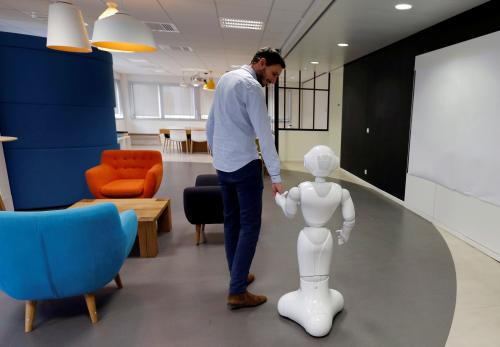Pension systems around the world faced a “stress test” during the pandemic—what you might call the “pension pandemic paradox.”
On the one hand, there was pressure to allow access to pension savings as emergency support during a period of sharp economic downturn. This was understandable, since for many people pension savings are their biggest financial asset. But, in some countries, this turned into unprecedented access beyond immediate emergency needs and put the pension savings system at risk. The most notable case was pension reform trailblazer Chile. A whopping $50 billion—approximately 25 percent of pension savings representing nearly one-fifth of Chile’s GDP—was withdrawn from the system during 2020 and 2021.
With the challenge of financing the Sustainable Development Goals and Paris Agreement still ahead of the world, our pension systems—like our architectural heritage—deserve to be preserved.
On the other hand, the long-term domestic capital that our pension savings represent was used to support short-term emergency measures. For example, Dutch and other European pension funds purchased “COVID-bonds” issued by the Nordic Investment Bank. CDPQ, which funds pensions in Quebec, joined the effort to support local enterprises impacted by the crisis.
And these funds are needed to support longer-term structural imperatives such as the transition to a low-carbon economy. Before the COVID-19 crisis, it was estimated that an approximately $2.5 trillion investment would be needed for developing economies to achieve a low-carbon transition and tackle the climate crisis. The Organization for Economic Cooperation and Development estimates that, post pandemic, this has increased to $4.2 trillion. To put that in perspective, the annual lending capacity of multilateral development banks is less than 10 percent of this. The patient capital of long-term investors across the world—managed most notably in pension and insurance funds—will be indispensable for financing this transition.
Pillars to pagodas
The pandemic also amplified and laid bare trends in the global labor force, which in turn reflect ongoing demographic changes to which our traditional pension systems have been struggling to adapt. Rather than a traditional structure of spending a period of our life in education, moving into employment, and then retiring at a set age, 100-year lifespans are increasingly becoming normal, and people are adapting and adopting a “multi-stage” approach to life. This will involve periods in employment, stints of self-employment, returning to education and training, and eventually combining activities—paid or otherwise—into old age longer. For people working in developing economies, this actually sounds familiar. It reflects the less-formal labor market structures that are the norm in poorer countries.
Even in advanced economies, pension systems will need to adapt to accommodate these new structures, becoming more flexible to reflect increasingly more fluid life stages. Instead of the “pillars” concept of pension systems promoted by the World Bank since the 1990s, we might have to think of our pension systems more as “pagodas.” Just as pagodas are supported by the shinbashira column at their center, a strong core of social protection should be at the center of any well-designed pension system, providing protection whenever needed throughout our lives. This can be designed in different ways—from “universal” pensions to subsidized contributions—and could be covered through general taxation to serve the redistribution core insurance function of any well-designed pension system. Tiers of pension savings would then hang from the central structure and be built around this central core, provided by employers, voluntary plans, and other arrangements.
Like a strong but flexible pagoda that adapts to shifting circumstances, these savings tiers could be designed to adapt to and meet the needs of our changing lifestyles. Unlike our current somewhat rigid pillars that are often tied to employment—with fixed parameters defining eligibility, amounts, and duration—these would to be designed more flexibly.
More flexibility on the “way in” to pension savings might involve linking contributions to consumption rather than income, while mimicking the simplicity, regularity, and “compulsion” elements of contributions though employers’ payroll. Flexibility in contributions might mean saving different amounts through our lives when we have more capacity to do so, mimicking the “Save More Tomorrow” technique now used across many corporate pension funds in the United States. Incentives to make up pension savings could be provided for people after taking gaps for training or family care.
Using new technology opens up avenues to use the insights from behavioral economics. These include innovative mechanisms such as “top ups,” which help us automatically save—redirecting spare amounts from our bank accounts or linking up to regular events such as the functions offered by companies such as Acorn and Qapital. Even such ideas as the “gamification of savings” are being tested, e.g., by the Long Game team.
Flexibility on the way out means allowing controlled access to our savings in specific circumstances. The ideas of “side car” accounts—combining a short-term savings account with longer-term retirement savings—is proving successful in trial by the NEST scheme in the U.K., among others. Including pension savings in credit scores to provide access to lower cost loans while incentivizing maintaining balances is another potential route.
Adding Eastern flexibility to Western strength
The fundamental purpose of our pension systems—first formalized in the “Averting the Old Age Crisis” World Bank report that kicked off a global questioning of traditional pension systems in the early 1990s—still remains the same: to provide for the vulnerable elderly in our societies and help people smooth their earnings and consumption over their lives. What has changed is the nature of our lives and livelihoods. Like pagodas, our pension systems will continue to come in different shapes and sizes—with slender or thick cores, and more or fewer levels.
We still have much to learn from the ancient Greeks. Our pension pillars still have a lot of strength—most notably the advantages that come from collective savings through employment, which keep costs low and arguably protect us from our own myopia by making saving both simple and automatic. We should blend this wisdom with learnings from Asian cultures—adding the flexibility that pagodas represent. With the challenge of financing the Sustainable Development Goals and Paris Agreement still ahead of the world, our pension systems—like our architectural heritage—deserve to be preserved. For this, the time-tested Corinthian columns that inspired the multi-pillar pension systems may have to be infused with Asian practicality, so that both discipline and durability are preserved.






Commentary
The post-pandemic prognosis for pension systems
May 3, 2022